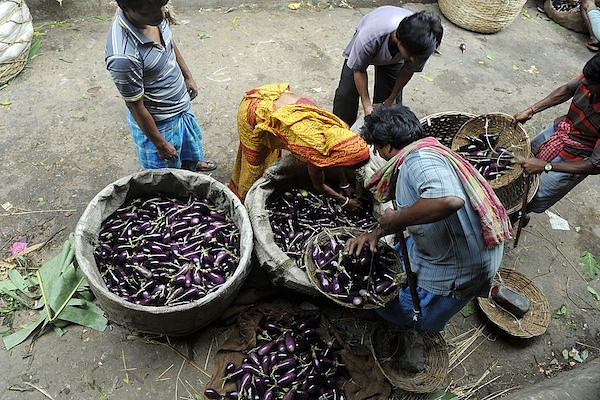
PM Modi’s Biggest Agri Reform, e-NAM, Hits States Roadblock
At the launch of e-NAM, the PM had exhorted the states to come on board and make the necessary changes in their respective mandi acts
Ever since, the states have failed to make sufficient progress in implementing the programme
Even the BJP or NDA-ruled states have not been enthusiastic about implementing the PM’s pet project
States perhaps fear that e-NAM would diminish the business of APMC mandis, which rake in thousands of crores in cess and other charges annually
On Ambedkar Jayanti this year (14 April 2016), Prime Minister Narendra Modi launched e-NAM (e-National Agriculture Market). It was touted as one of the biggest agriculture reforms of the post-Green Revolution era. It even received a mention in the current Union budget, with an allocation of Rs 200 crore for its implementation. Twenty-five commodities, including wheat, paddy, maize, onion, jowar, bajra, groundnut, potato, soybean and mustard seed were selected for e-trading.
The idea of e-NAM was to allow farmers to sell their produce to the highest bidders outside the Agriculture Produce Market Committee (APMC)-regulated mandis. The plan initially aimed at integrating 21 mandis across eight states, namely Uttar Pradesh (6), Gujarat (3), Telangana (5), Rajasthan (1), Madhya Pradesh (1), Haryana (2), Jharkhand (1) and Himachal Pradesh (2).
At the launch, the PM had exhorted the states to come on board and make the necessary changes in their respective mandi acts. But since then, the states have not seemed interested in the proposed plan.
Pravesh Sharma, former IAS officer who was associated with the initial phase of planning and design of the e-NAM initiative, wrote in The Indian Express that the Maharashtra government has backtracked from its decision to take Foods and Vegetables (F&V) out of the purview of APMC mandis in the face of stiff resistance from traders and elected officials in these regulated markets.
F&Vs were not included in the platform for their proclivity towards price fluctuations, but Maharashtra government’s bold move had seemed like a step in the right direction. Now, the U-turn comes as a surprise. If the government had gone ahead with its reform, it would have helped the large farmer community in the state significantly, as Maharashtra is a leading producer of a range of F&V, from grapes, pomegranates, oranges and mangoes to onions.
But Maharashtra is not the only state not making progress. Pravesh explains how even the BJP- or NDA-ruled states have not been enthusiastic about implementing the PM’s pet project.
He writes: Major agricultural states, including Punjab and Maharashtra, are unwilling to adhere to even certain basic conditions, such as allowing traders outside the state to bid online. Gujarat rejected the use of the NAM software and floated its own tender to develop a local version, creating major problems for integration. Madhya Pradesh allowed NAM in just one out of its total 546 mandis. Haryana said it would experiment with a single crop — that too, safflower, a minor rabi oilseed. Meanwhile, Tamil Nadu continues to ignore requests to submit its proposal for implementing e-NAM.
Unfortunately, this is the current situation in many states despite the many compromises made by the Central government to get the states on board.
Why states aren’t willing to implement e-NAM
e-NAM threatens the monopoly of APMCs over the farmers’ produce.
According to Pravesh, when the states were invited for consultation, they almost unanimously opposed the idea of giving farmers total freedom to sell their produce on the proposed online platform. They feared it would diminish the business of APMC mandis, which rake in thousands of crores in cess and other charges annually, besides undisclosed amounts as rents to mandi functionaries, in return for allowing traders to bypass the maze of rules. For instance, in 2014-15, the combined turnover of APMCs in Maharashtra alone was Rs 67,000 crore.
Additionally, the APMC sector in the state is dominated by politicians from political parties that have ruled the state the longest.
Reforms stuck despite Centre’s compromises
To cajole the states, Pravesh writes, the Centre agreed that the NAM portal would operate only from centres authorised by the APMCs of the concerned districts, i.e., within the existing mandis, so that that they could continue charging cess, and thereby protect their revenues. In addition, the APMCs were offered the NAM software for free, along with a one-time Central grant for the purchase of computers, printers and other hardware.
Despite such compromises by the Centre, the progress displayed by the states is disappointing.
The way ahead
Pravesh proposes two ways to salvage the situation and move towards the goal of creating a unified national market for trading farm produce in a limited period.
First, the mandate of running NAM should be transferred from the Small Farmers’ Agribusiness Consortium (SFAC), a registered society, to a commercial entity, with 50 percent ownership of the Centre and the remaining held by a private sector entity chosen through competitive bidding.
Second, the Centre should come up with a Right to Trade legislation as a legal enabler for ushering in NAM.
Since cooperative federalism is not working well in this area, the PM would do well to intervene if he wants to realise his goal of doubling farmers’ incomes by 2022.
Further Reading:
Harvesting The Benefits Of Electronic National Agriculture Market – 10 Focus Areas
The National Agriculture Market Is A Big-Bang Reform - But Can The Government Pull It Off?
Farmers Will Discover Prices And Agents Are Going To Disappear In National Agri Market
[Video] All You Wanted To Know About The National Market For Agriculture